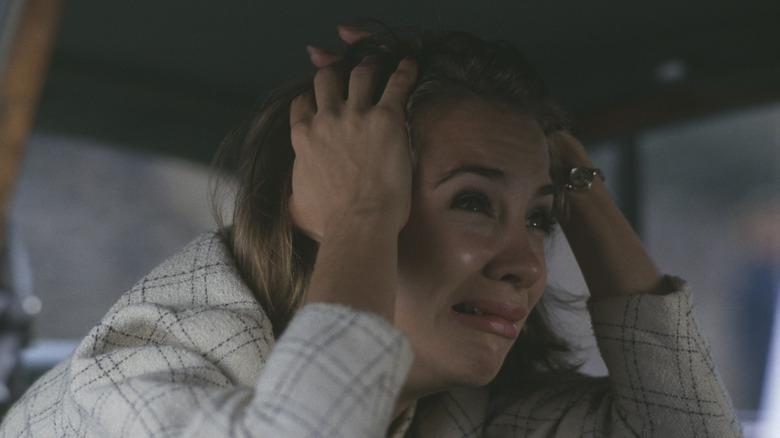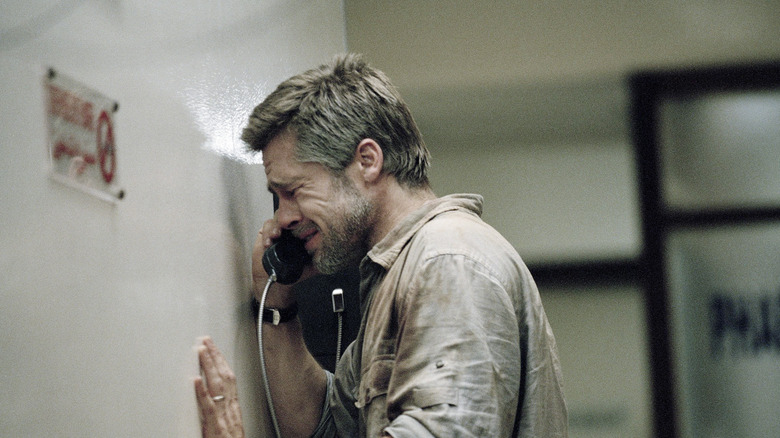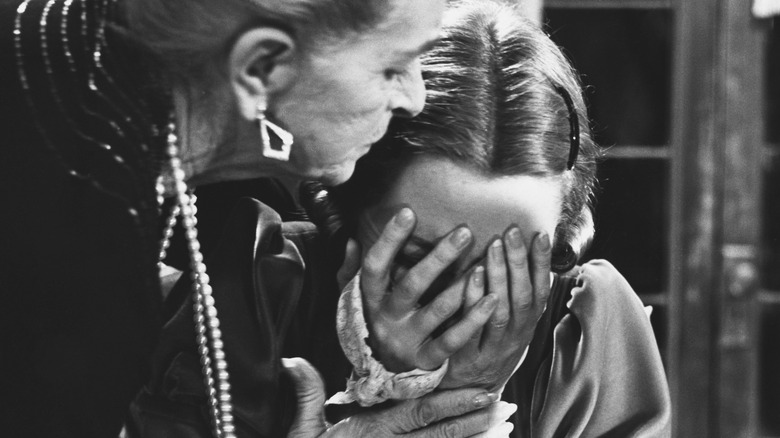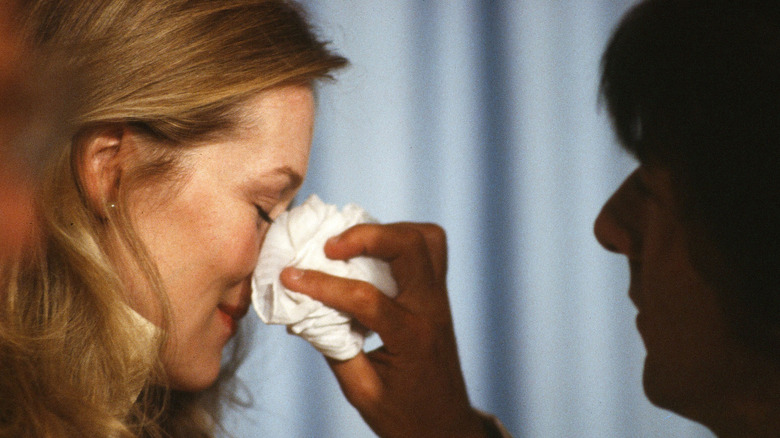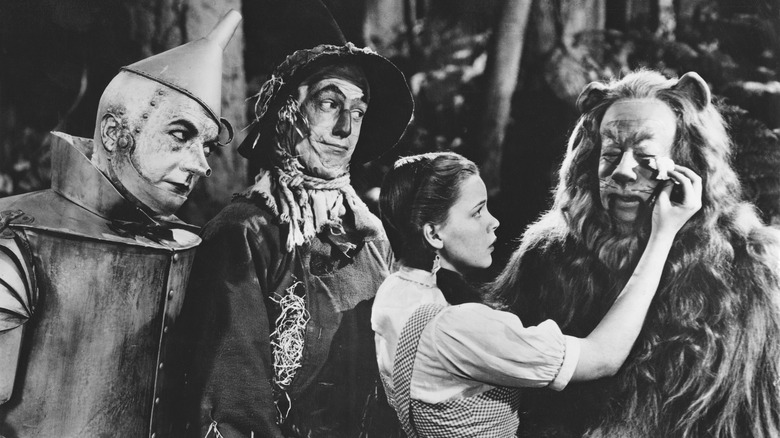How Actors Make Themselves Cry For Movies
No doubt some of us have tried to do as the professionals do and make ourselves cry on cue. Yawning on cue is a pretty common talent, and a contagious act, to boot. Burping on cue? Doable for the more indigestive of us. Farting? We can leave that to legendary 12th-century jester to King Henry II, Roland the Farter. But crying? It usually requires some deep, real emotion that wells up in the chest and can't be faked.
Take actor Bryce Dallas Howard, who demonstrated her excellent crying on command powers on "Late Night with Conan O'Brien" back in the day in 2015. Note the eyebrows pursing further and further, the lips pulling further and further back, the gradual flow of feeling into her face, the reddening around the eyes, and hint, hint: the lack of blinking plus the drinking of water before giving it a go. There are some general tips in there that any actor or non-actor could use to cry, but clearly someone like Howard has a real knack for it.
On the more conceptual side of things, we've got teacher Charlie Sandlan at the Maggie Flanigan Studio in New York City. Sandlan teaches the tried-and-true Meisner technique of acting and approaches crying from a very psychological, inward-looking perspective. He told USA Today, "The more open you can be, the more empathetic you can be to another person's pain," the better you'll be at crying on cue. This advice is pretty vague, but there are other, specific, executable, repeatable techniques that actors can use to cry on command in movies.
Method #1: Leverage a real-life event
Much of the advice about crying on cue comes from acting schools, talent agencies, theater companies, and such. Those sources almost universally agree on methods to make oneself cry, particularly the deepest, darkest, most emotionally difficult of them all: drawing on feelings from a real-life event.
Casting Frontiers, for instance, goes right for the emotional throat and recommends thinking about nothing less than a euthanized a pet or "losing a loved one to cancer." Yikes. The Melmack Acting Studio recommends much the same and emphasizes that the purpose behind this technique is to avoid faking crying and therefore making the acting seem insincere. That studio and Masterclass both recommend doing this kind of exercise within the framework of the character one is playing. In other words, if you can't fully embody a character then you can look for "parallels" to one's own life. Actors have to dig through their own emotional pain and baggage quite a bit. It isn't the easiest of jobs despite visions of leisurely living, ultra-rare multimillionaire kind of Hollywood stars.
Such thoughts bring to mind the aforementioned advice from Charlie Sandlan at New York's Maggie Flanigan Studio. He advised against not hiding from one's emotions. Don't push back or hold back, and let the tears happen.
Method #2: Use psychological triggers
Strictly speaking, "triggers" — as they're called — could be considered closely related to envisioning real-life memories. But, there's a twist. Instead of just recalling a generally tragic event, the actor in this case knows precisely what will "trigger" him or her. This could be a specific instant in a memory like a frame in a film, a particular physical action that initiates the buildup to crying, recalling a moving line from a poem or song, looking at a certain object that holds strong emotional power, and more. The more specific, the better. Needless to say, this technique requires an actor having enough experience to know what will provide the trigger. As "Luke Cage" actor Mike Colter plainly says on Backstage, "You should know your triggers" and have them available for use.
There are a bunch of caveats to this method, which we suppose could apply to any other method used to cry on cue. First off, knowing how to pull back when triggered is just as important as knowing how to start crying. Otherwise, an actor runs the risk of sinking deeper into feelings that could impact real life in a bad way, especially if dealing with traumatic associations repeatedly torn open like a wound. It's called "acting," after all, not "re-living." Also, some people are just more sensitive than others and can be easily moved. But even a naturally sensitive person requires technique and practice.
Method #3: Work yourself up before a scene
The next method that actors use to prepare for crying scenes might not seem obvious at first but will make sense for those with kids. A kid who's worked up is hard to calm down, and the more worked up the harder it is. Same thing with someone who's calm. A calm, even person can be hard to rile — barring triggers, remember. So, if an actor knows ahead of time that a scene requires some intense emotion, including crying? That actor might try intentionally riling themselves up to reach a breaking point.
The Toronto Film School calls this method "mood swinging," and advises not just plumbing the depths of sad and horrible feelings but happy feelings, too. This would require some of the same real-life memory work and perhaps the triggers mentioned above. Casting Frontiers describes using opposing experiences to evoke the enormity of the other, like remembering one's favorite moments with a father in conjunction with remembering that father's final days, stricken by disease. This is a pretty harsh way to treat oneself for the sake of work (acting is a job, remember), and ought to come with some of the same mental health provisions we described earlier. Namely: knowing when to pull back and knowing the difference between acting and re-living.
Also, timing is critical with a technique like mood swinging. It would have to be very well-timed to lead into whatever scene an actor is performing.
Method #4: Use physical techniques to invoke crying
Not every actor is able to plunge into the horrors of emotional hell and divest demons of trauma and grief for the sake of crying on cue. Not every day is the same as the last, anyway, and making oneself cry might be easier yesterday than today. Nonetheless, Charlie Sandlan of New York's Maggie Flanigan Studio told USA Today that certain actors are skilled and/or experienced enough to make crying on cue look easy, citing Jason Bateman, Timothée Chalamet, and Sarah Paulson. "When you watch them work, they don't strain, there's no effort involved," Sandlan said. Nonetheless, even the most seasoned professionals might need a helping hand. To wit: some of the same physical techniques we described Bryce Dallas Howard using when talking to Conan O'Brien.
The Bridge Theatre Training Company cites two things that we mentioned Howard doing: not blinking and drinking enough water. We all know that keeping one's eyes open hurts and is really difficult. It also causes the eyes to tear up and stay moisturized. And to produce moisture we need water — hence staying hydrated. We also mentioned yawning on cue earlier, and everyone knows that yawning can make the eyes water. On that note, it's possible to manipulate the jaw and breath to do little yawns with the mouth closed to produce tears. Keeping one's breath shallow and fast is another way to evoke the kind of physiological mechanisms associated with crying.
Method #5: When in doubt, use a hack
Finally, we come to a crying-on-cue method that anyone can do: cheat. Even renowned actress Cate Blanchett has a go-to hack to cry on command, as she explained while involuntarily tearing up from eating spicy chicken wings on Hot Ones: pluck a nose hair. This is a technique specific to Blanchett, although if some folks want to try it to see if it works, well ... find a mirror and have at it.
The Toronto Film School mentions other hacks, which we distinguish from physical techniques like yawning because they require some outside object/product or janky physical intervention. The tear blower is such a product, like the Kryolan 3000 Tear Blower Menthol available on Amazon (yes, such things exist). As the very brief product byline says: "creates immediate real tears." Strictly speaking, a tear blower could be something as cheap as an empty paper towel roll that a second person with bad breath blows into. But, a paper towel roll wouldn't come equipped with the second part of that blower product: menthol. Menthol can make a person tear up, and there are even menthol sticks a person can rub under the eyes like lip balm.
Even more basic than these products are two things you can get at any random drugstore: eye drops and petroleum jelly. The first will make your eyes look watery, and the second will make the area around your eyes look glossy as though you've been sobbing. Like we said: hacks.

